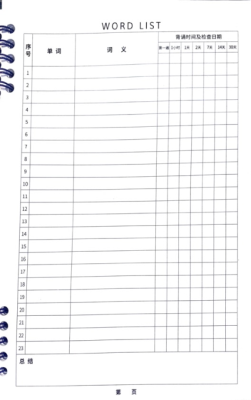Japanese Word Memory Techniques.
Japanese language learning, word memory techniques. -- Are you reviewing properly, everyone? ☺️
日本語学習、単語の記憶術。—— 皆さん、きちんと復習してますか☺️?
Key Point
🧠 Tips for Reviewing Based on the Forgetting Curve
- Do brief reviews on Day 1, 2 days later, 7 days later, 14 days later, and 30 days later.
- With repeated reviews, your retention rate increases and the time needed for each review decreases.
- The key is: “It’s okay to review for a short time—as long as you do it frequently.”
📘 Vocabulary Review Method
- Take 5 to 10 minutes before bed to revisit the day’s vocabulary.
- Focus on pronunciation (kana) and repeatedly confirm meaning and usage.
- Reviewing right when you start to forget strengthens memory retention.
🧩 Grammar Review Method
- Spend about 10 minutes on weekdays to focus on understanding and reciting Textbook.
- On weekends, use Practice weekly news or workbooks to reinforce applied skills.
⏱️ Time Management Tips
- Set clear time limits like “Finish this task within 10 minutes” to boost focus.
- Even short study sessions are effective when done consistently
🧠 忘却曲線に沿った復習のコツ
- 1日目・2日後・7日後・14日後・30日後に短時間で繰り返し復習する。
- 復習を重ねることで、記憶の保持率が上がり、復習にかかる時間も短縮される。
- 「短くてもいいから、何度も」がキーワード。
📘 単語の復習法
- 寝る前に5〜10分でその日の単語を再確認。
- 発音(かな)を重視し、意味や用法を繰り返し確認。
- 忘れかけた頃に再度復習することで、記憶が強化される。
🧩 文法の復習法
- 平日に10分程度、テキストの暗唱や理解に集中。
- 週末にはWeekly Newsやワークブックで応用力を高める。
⏱️ 時間管理の工夫
- 「10分以内に終わらせる」など、明確な時間設定で集中力を高める。
- 短時間でも継続することが大切。
(1)Description (1)ディスクリプション
Recently, one of my students came to class with notes like this.
最近、私の生徒さんのひとりが、 このようなノートを持って授業に臨んでいました。
When I asked to see it, it turned out to be notes that could be used to review vocabulary along the "forgetting curve."
見せてもらうと、忘却曲線に沿って、 単語を復習できるようになっているノートでした。
Today, let's talk about the forgetting curve, and how to effectively review Japanese along the forgetting curve.
今日は忘却曲線について、そしてその忘却曲線に沿って、 どのように日本語を復習するのが効果的なのかについてお話ししましょう。

(2)Main Topic (2)本題
According to research from the University of Waterloo in Canada, the so-called forgetting curve is a graph that shows how information is retained or eliminated in the human brain once humans acquire information.
カナダのウォータールー大学の研究によると、 忘却曲線とは、一度取り入れた情報を、 人間の脳はどのように保持、または消去するのかを表したものです。

Reference: https://uwaterloo.ca/campus-wellness/curve-forgetting
Assuming the amount of information gained in a one-hour lecture. On the first day, there is no information, starting from 0%, and reaching 100% by the end of the lecture.
1時間のレクチャーで得た情報量を仮定しています。 1日目は情報量が全くない、0%のところからスタートし、 レクチャーが終わる頃には100%に達します。
If you don't review the information gained in the lecture at all, by the second day, 50%〜80% of the content will be forgotten. By the seventh day, more will be forgotten, and by the 30th day, only 2%〜3% of the lecture content can be remembered.
レクチャーで得た情報を全く復習しなければ、 2日目には50%〜80%の内容を忘れてしまいます。 7日目にはより多くのことを忘れ、 30日目にはレクチャーの2%〜3%の内容しか記憶していません。
To change the shape of the (graph) curve, you need to review at appropriate times.
カーブの形を変えるためには、 適切なタイミングで復習をすることです。
In addition, as you review more and more, the time required for each review becomes shorter, and this graph also shows this point.
また、復習をすればするほど、 一度の復習に要する時間が短縮されるということも このグラフに表されています。
In other words, the more you delay reviewing, the more you waste the review time that could originally be saved.
つまり、復習を先延ばしにすればするほど、 節約できる復習の時間を無駄にしているということです。
So, specifically speaking, I will use the textbook "Ayumi" to introduce my recommended review method.
私のおすすめの復習方法をご紹介します。
(1) First is vocabulary.
(1) まずは単語です。
After learning new vocabulary, before going to bed that night, even if it's just 5 or 10 minutes, please try reading it again and confirming the meaning of the words.
新しい単語を勉強した後は、その日の寝る前に5分、10分でいいので、 もう一度読んでみて、意味を確認してみてください。
Do the same thing the next day, 2 days later, 7 days later, 14 days later, and 30 days later. You should be able to better consolidate the vocabulary (memory) than before.
同じことを、次の日、2日後、7日後、14日後、30日後にします。 今までよりも単語の定着が図れているはずです。
(2) Then there's grammar.
(2) 次は文法です。
According to University of Waterloo research, in addition to this kind of short-term review, if you add about 30 minutes of study time on weekdays, it seems to bring better learning results.
ウォータールー大学によると、 この短時間の復習に加えて、平日に約30分間、勉強する時間をとると、 さらなる学習の向上につながるようです。
During this time, please understand and recite the Practice A pages. If you get a little tired of memorizing, set aside some time on weekends, and try focusing on problems using Practice B, C, workbooks, etc.
その時間に、練習Aのページを理解し、暗唱してください。 暗記することに少し飽きてきたら、週末に、まとまった時間をとって、 練習B、C、ワークブックなどを用いて問題に取り組んでみてください。
(3) Finally, the key to reviewing is to carefully decide on time and execute it, like "Let's finish this task within 10 minutes," etc.
(3) 最後に、復習するときのコツは、 「10以内にこのタスクを終わらせる」など、 細かく時間を決めて行うことです。
The time spent on one review session can be short, that's fine. What's more important is repeating this kind of short review multiple times.
1回の復習にかける時間は短くていいんです。 その短い時間の復習を何度もすることに重要性があります。
(3)Conclusion (3)結論
Review is not about learning new things, so it's not interesting and doesn't really motivate you.
復習は新しいことを学ぶわけではないので、 面白みもないし、なかなかモチベーションが上がりませんよね。
However, if there's a teacher, you can give yourself just the right amount of pressure, and have an environment that makes it easier to review.
しかし、先生がいれば、程よいプレッシャーを自分自身に与えることができ、 復習がしやすい環境となります。
At Watashi, we conduct vocabulary and sentence pattern review quizzes for the purpose of reviewing each time. Let's learn Japanese more effectively together with us!
Watashi では、 毎回復習を目的とした単語テスト、文型復習テストを行っています。 私たちと一緒に効果的な日本語学習を行なっていきましょう!
筆者:MK 翻訳者:林暁旻

 Choose Language
Choose Language  中文
中文  日本語
日本語 

